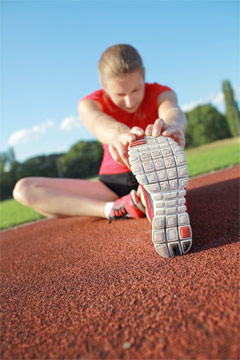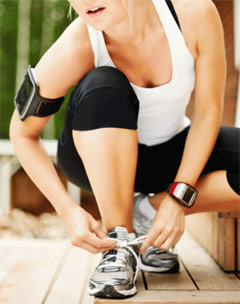|
 , ,
Font size |
Top 10 Training Tips for Runners
 Whether you're an elite athlete focused on winning or a beginner simply hoping
to stagger across the finish line, you can expect one thing from yourself: your
personal best. Whether you're an elite athlete focused on winning or a beginner simply hoping
to stagger across the finish line, you can expect one thing from yourself: your
personal best.
Runners need
to pay attention to their training regimen and protect their entire body,
as well. There are different elements that need to be covered under your
training regime. Read on...

Heart Smart-- The intensity of a marathon can be dangerous, do
not enter a raise without a cardiac check. Runners should seek a clearance
from their doctor before running a marathon. After this, they should start
their runs off slowly and gradually increase their speed to help the heart acclimate
to the work ahead.

Fluid Intake --Avoid
ingesting too much water both, before & during the race, to prevent a drop
in the serum sodium level, which can cause an individual's cells to swell.
This condition is called hyponatremia can be prevented by eating foods with
high sodium content and drinking sports drinks for a few days before a
marathon.

Water to starve off dehydration: According
to experts, a good rule of thumb is to drink about one cup of fluid every 20
minutes, while on a run. If you need to drink more, choose a sports drink that
contains some salt. Left untreated, hyponatremia can be fatal. Symptoms can
include vomiting, loss of appetite,
headache, restlessness/fatigue, abnormal mental status, muscle weakness, or
convulsions. Runners should seek immediate medical attention if they
experience any or all of these conditions during or shortly after a
marathon.

Hip Mobility --
Increasing flexibility and strengthen of
the core,
glutes, hip,
and thigh muscles
can help improve or even eliminate hip pain in runners. Try incorporating yoga or Pilates into
your training routine. Both of these exercise regimens can strengthen your
hips and can help prevent pain and injuries.
 
Improve Knee Support- Incorporate side leg raises to improve
glutes performance. This muscle group stabilizes the pelvis and
help support the knee. Stretch your
hamstrings and IT
bands for at least 45 to 60
seconds each after every run. This will allow the muscle fibers to stay
stretched as you increase your mileage.

Foot & Ankle -- Do not
force the foot into a specific posture for this can increases the risk for
injury. It is better to select the shoe that best fits you and is most
comfortable. Also, orthotics can decrease the impact stresses for long
distance runners, so picking up a pair of over-the-counter orthotics can
help prevent injuries. Orthotics should never be prescribed without a
thorough examination � at least a half hour, and more if the case is
complex.

Rest before the Race :
Runners preparing for a race need to be well rested. Seven to 10 days before the
marathon, runners should set a standard bedtime and wakeup time that provides
them with seven to eight hours of sleep. Try to avoid alcohol and caffeine as
they interrupt peaceful sleeping.

Build slow on Pace: The established rule is not to boost your
miles by more than 10% per week, while on a training
program. Speed work can make you faster, but it also ups the risk of
injury, especially as you age.

 Avoid Over-training: Check
your resting heart rate every morning, if you see a big jump, you probably
are overtraining. If your morning heart
rate is normally 60, for
instance, and goes up to 61 or 62, no big deal, but if it gets from 60 to
72, back off and recover. Avoid Over-training: Check
your resting heart rate every morning, if you see a big jump, you probably
are overtraining. If your morning heart
rate is normally 60, for
instance, and goes up to 61 or 62, no big deal, but if it gets from 60 to
72, back off and recover.

Maintain Positive Thoughts: Distract your attention from the
long never ending distance. Count stop signs. Play word association games.
Do math problems in your head. Even counting your own footsteps can help
take your mind off pain, boredom and other negative thoughts; before you
know it, you'll be back in that blissful, meditative head space that makes
running so desirable in the first place.
There's no doubt that training for marathon is tough. It requires stamina,
commitment and heart.
Input Support:
Dated 07 November 2013
|









